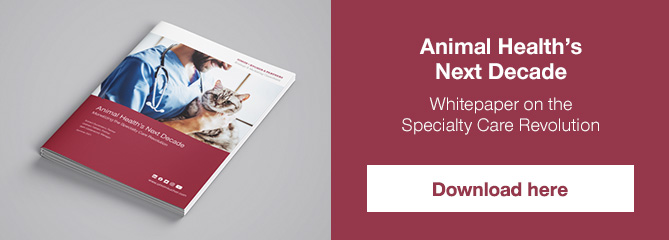Animal health is set for a specialty care revolution – but monetizing innovation is not easy. The nascent field of specialty medicines brings with it a swathe of product development opportunities, treatment modalities, value propositions, and price points. Drawing lessons from human health, we explore this new innovation frontier.
Basic care of companion animals has been increasingly addressed via preventatives, antibiotics, and overall pet medicalization. Early industry movements point to an impending wave of specialty product innovations arriving over the next decade. These products will come in new shapes and sizes, posing fresh questions for commercial organizations.
- Which products and features should be developed?
- Which therapeutic areas drive commercial value?
- How to craft compelling new value propositions to vets and pet owners?
- How to balance revenue, profit, and volume goals?
- Which new go-to-market tools are needed to bridge affordability challenges and data uncertainties?
- How to mold the commercial organization to best extract value?
New commercial and monetization models are required. But is the market ready to bear this innovation? In our recent paper, we share six factors that welcome the arrival of specialty medicines:
- Market fundamentals have never looked stronger: Increased disposable income, a desire for companionship, and shifts towards remote working patterns among pet owners is driving additional potential across the companion animal sector. Growth breeds innovation in a virtuous cycle, and the market shows no signs of slowing down.
- Vanguard products demonstrate space for high-cost pet medicines: The market’s willingness to pay for next-generation therapies has undergone a first stress-test. Zoetis’ chronic treatment Cytopoint enjoyed blockbuster success, while Elanco’s Tanovea established a new line in cancer. Swelling biotech pipelines and fund-raising activity demonstrate that the opportunity has been recognized by innovators and investors alike.
- Development costs brought down to earth: AH stands to benefit from the successes of the >$200bn/year human biopharma market and its scientific validation, expertise, economies of scale, and increased manufacturing capacity, opening up a once prohibitively expensive route of R&D. While the size of the prize in AH has historically paled in comparison to human health, the potential ROI will become more evident, driving activity in this space.
- Specialty meds keep the vet the hero of the story: Veterinary clinics are under fire. Healthy margins on medicines sales are strongly undermined as consumer demand shifts to lower priced e-retailers. Telemedicine threatens to reduce the number of in-person consults per client, while widespread corporatization of clinics standardizes and commoditizes the service offering. Specialty medicines offer a new arsenal to drive clinical and economical value to practices.
- Pet insurance helps absorb the price of innovation: As vet costs and pet owner spend rise, there will be a continued increase in coverage (and premiums) as owners protect themselves from steep and unpredictable out-of-pocket bills. Inflation of veterinary costs may follow as owners’ “elasticity” to incremental treatment costs diminishes. Insurers may emerge as key market access gatekeepers, using coverage as a differentiator.
- Growth engines switch fuel from M&A to innovation: Consolidation is the name of the game this decade. Large commercial organizations have emerged with great reach and expertise in sales and marketing. Yet the opportunities to buy earnings are drying up – the next stage of growth requires innovation to insulate against the gradual erosion of a cash-cow, primary-care business to low-cost, generic players.
The combination of these market factors will make an unprecedentedly attractive and receptive landing zone for upcoming specialty medicines in animal health. Yet bridging the transition from today to the future is fraught with challenges and must not be underestimated.
A key challenge lies in whether and how to transition from large, heterogeneous product portfolios toward specialty innovations. The larger AH companies today typically carry a wide and complex mix of products across therapeutic areas. A well-balanced and diversified portfolio helps embed manufacturers as key suppliers in the value chain. But this has not been without tension. Management, sales, and marketing teams are faced with whether to be a “solution seller” or an “innovation seller”.
Embarking on the specialty journey: lessons from human health
- Specialty focus: Human pharma has shown it pays to avoid tunnel vision focus on cash-cow portfolios. Specialty product development keeps a very clear commercial eye on the needs of the market. Prioritizing the right technologies, disease targets, products, and features based on the voice of customers can be the difference between a blockbuster and a me-too, but also between a franchise-builder and a future divestment candidate.
- Central value & pricing capabilities: Successful biopharmas build an arsenal of evidence around their products to defend a relatively consistent regional, if not truly global, value and pricing position. This has only been possible through the build-up of centralized, sizeable and dedicated pricing capabilities – typically sat within Pricing & Market Access and Health Economics & Outcomes Research (HEOR) – alongside classical marketing and commercial functions. AH companies should look inwards to their own capabilities and ask whether those organizations are set-up for commercial excellence in a specialty medicines world.
- Innovative pricing solutions: Bringing a suite of contracting solutions and patient assistance programs to market has become a fundamental capability of Pricing & Market Access teams in human pharma. Whilst animal health manufacturers face vets and pet owners rather than healthcare budgets and their payers, the challenges will be remarkably similar – risk-sharing, cost-spreading, and affordability assistance. AH companies would do well to start preparing their offers for the future.










